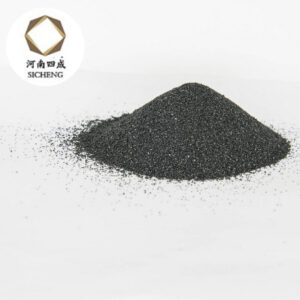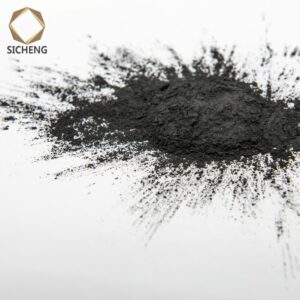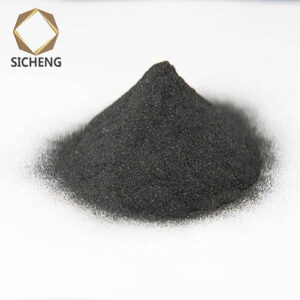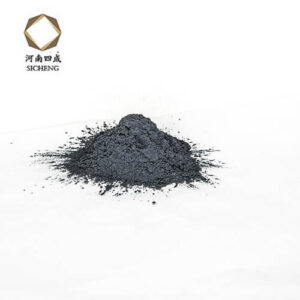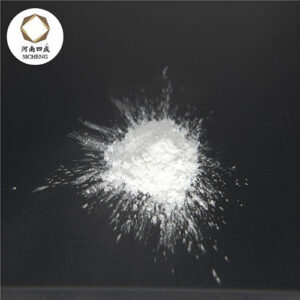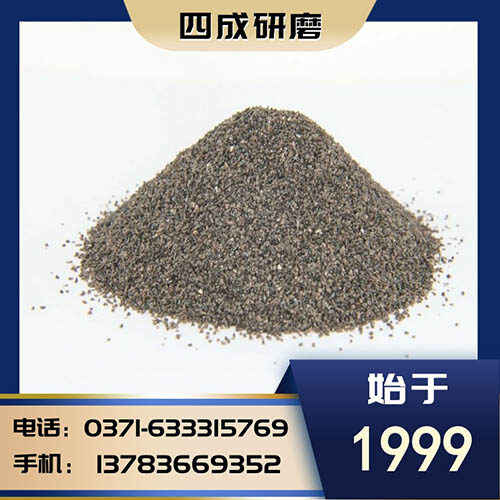Brown corundum Smelting process method and characteristics:
(1) Process characteristics: (1) Furnace temperature > 2050 °C. (2) Charge level in the furnace: upper solid layer, middle semi-molten layer, lower molten layer. (3) Electric energy distribution in the furnace: arc heat, resistance heat. (4) In the smelting process, the melting depth and melting area are ensured at any time by controlling the power, batching ratio and material layer thickness.
(2) Process method:
Oven method (submerged arc method):
Features: (1) The furnace with thick material layer and capacity of 1800~2500KVA, the initial thickness is generally about 600~1000mm; The initial thickness of furnaces below 1000KVA is generally about 400~600mm. (2) The granularity is large. (3) The arc is completely covered by the material layer.
Advantages: (1) High heat utilization. (2) The loss of electrode and furnace lining is small, and the degree of high temperature radiation of the upper equipment of the furnace body is small. (3) Reduce the harm of radiant heat to workers.
Disadvantages: (1) There are many recycled materials in the fixed furnace, the consumption of raw materials increases, and the amount of labor is large (little impact on the dumping furnace operation). (2) The hourly feeding amount is large, the operation is improper, the melting speed of the melt is fast, the heat source center is moved up, and the molten pool area is small. (3) Easy to cause spray oven. (4) The fixed furnace is easy to produce the phenomenon of mixed corundum and ferrosilicon or uneven quality of various parts of the frit.
Open furnace method (open arc method)
Features: thin material layer, fine particle size, long arc exposure time, material layer thickness is generally 300mm.
Advantages: (1) High charge utilization rate. (2) The molten pool temperature is high and the melting area is large. (3) The molten viscosity is small, the ferrosilicon alloy is easy to be separated centrally, and the mass of the frit is uniform.
Disadvantages: (1) Low heat utilization. (2) Long smelting time and low production efficiency. (3) The furnace lining and electrode oxidize quickly, and some equipment is often in the high temperature radiation area, which affects the life. (4) The environment in front of the furnace is poor.
General operation process of brown corundum smelting:
(1) Preparations before starting the furnace: ① Connecting the electrodes: Blow the static contact surface and tighten the thread. ②Adjust the length of the electrode: the electrode just touches the arcing coke, which does not affect the access or dumping of the furnace body. ③ Measure the electrode distance and the distance between the electrode and the furnace wall. ④ Measure the insulation of the secondary conductive system: the resistance value of the insulation part is > 0.5MΩ. ⑤ Check the system equipment such as furnace transmission, electrode lifting, feeding, etc., as well as water, air pipes, valves, etc.
(2) Furnace opening: ① Arrange the starting coke: the particle size of the starting coke is 30-50mm. There are three placement methods: solid triangle: large amount of arc starting coke, not easy to break the arc, used in the middle. Hollow triangle: small amount of arc starting coke, easy to break the arc, not commonly used. Crystal shape: small amount of coke for starting arc, fast arc starting, easy to break the arc, and used for furnace opening. ②Power transmission: ③Arc starting: Use higher voltage, when the current rises to 20-30%, increase the block of bauxite to press the arc, and when the current load rises to 80%, you can add materials to enter the smelting.
(3) Smelting: It is mainly divided into two processes: the stewed furnace method and the open furnace method (see the third point for details on the smelting process and characteristics of brown corundum). Do a good job of “control” operation and furnace condition analysis.
(4) Control: generally stop feeding, control the rise of the electrode, and do not deal with small reactions. The resulting reactive block or “chick block” is post-processed. In order to prevent the phenomenon of suspension.
(5) Refining: ① Before turning to refining, adjust the proportion of ingredients and increase the amount of carbon appropriately. ②Stop feeding, thin material layer, low voltage, high current operation.
(6) Inverting (exiting) the furnace: ① Start the electrode first, and then turn off the power when the current is not less than 5000A. ② The dumping furnace is ready to receive the package 0.5 hours in advance, and the cooling water is turned off. ③ When pouring, follow the principle of slow first, then fast, and finally slightly slower. ④Leave a little melt to facilitate the next arc strike. ⑤ Pay attention to the tilting angle to prevent the furnace nozzle from touching the crimping package. ⑥After pouring and resetting, when the electrode is 200-500mm away from the melt, start to send electricity.
(7) Precautions: ① During the smelting process, if there is no abnormal phenomenon, send the full load as required, and reduce the number of electrode activities. ②The furnace does not cut material for a long time, and the movable electrode can force the material to be lowered for 30-40 minutes. ③ After the large reaction equipment of the electric furnace is damaged, or the power outage lasts for a long time, pay attention to the active electrodes. ④ If the electrode is stuck, it should be lifted first. ⑤ Concentrate and run at full capacity according to the process.
5. Operation methods in the smelting process:
(1) Arcing: the method of using carbon material as the conductor to start the arc when the furnace is turned on; operating points: the pendulum method of the arcing coke; use a higher voltage, and gradually put it into the arc after the current rises and stabilizes , to prevent arc break.
(2) Simmering furnace: That is to say, the material layer is relatively thick, generally 0.4-1M arc light is opaque, and the heat utilization rate is high; operating essentials: use intermittent feeding, regularly simmering furnace, and cooperate with “control” operation. Deflate the air regularly to avoid excessive air pressure, which may cause burnout. Less moving electrodes, balanced and full-load power supply. The lumpiness of bauxite is less than 30mm, and the amount of fine powder is small.
(3) Control: Essentials: do not add or add less material within a certain period of time to promote the electrode to drop, expand the area of the molten pool, and increase the temperature of the melt. Operation method: control feeding, control electrode rise; generally small reactions are not treated; batching layer drops, melt fluidity is good, and the current is unstable, then it can be transferred to feeding smelting.
(4) Degassing: A large amount of CO gas is generated during the reduction reaction process, which must be removed to prevent large blowouts; operating specifications: the thickness of the material layer and the degree of melt block should be appropriate to maintain air permeability; , after the gas has escaped completely, block the cover with a large piece of spent material;
(5) Addition of waste material returned to the furnace: it is mostly added in layers with the bauxite mixture in the middle of smelting, and added to the melting zone of the furnace.
(6) Use of micronized powder in the furnace: when the collapsed hole exposes the liquid surface, first cover the micronized powder to form a hard cover before adding materials; When the material layer appears sintered, it is used to pour it into the solution surface; Add the middle of the three electrodes before stopping the furnace, or pour it in from the electrode root.
(7) Feeding: that is: passing the surrounding charge to the center; In the control and refining phase, the surrounding hot charge is gradually pushed towards the high temperature area.
(8) Pounding: the material layer sintering is serious and the charge sinks; Method: When other measures are ineffective, the furnace can be unloaded; Raise the electrodes, item by item; Overflow the molten liquid, cover with micronized powder, and then stir.
(9) Refining: stop feeding until the charge is melted; Operating specifications: lower voltage; Frequently move the electrode to pat the charge to prevent sintering; Brush the surrounding charge towards the center and gradually melt clean.
(10) Stop the furnace: after melting, the power can be cut off for about 30min after refining; Operation essentials: the electrode can be covered with micronized powder; Stick sticks often to ensure that the quality of the three phases is similar;
Normal situation of furnace shutdown: white-blue flame comes out of the electrode head; The arc is long and extremely unstable; The current is unstable, and a soft cover appears on the liquid level.

